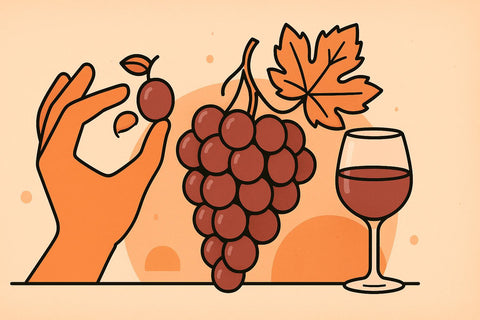You’ve probably seen them hanging in tight clusters on sun-drenched vines, destined for barrels and bottles. Wine grapes—those small, dark, intensely flavored fruits—are the backbone of the global wine industry. But if you’ve ever wandered through a vineyard or been handed a bunch at a farmer’s market, you might’ve wondered: can you actually eat these? And more importantly, should you?
It’s a fair question. After all, grapes are grapes, right? Not exactly. Wine grapes and table grapes are cousins, not twins. While table grapes are bred for snacking, wine grapes are cultivated with fermentation in mind. Still, that doesn’t mean they’re off-limits to your taste buds.
This article breaks down everything you need to know about eating wine grapes—from their flavor and nutrition to safety and culinary potential. Whether you’re a curious foodie, a home gardener, or someone who just stumbled across a vine and got hungry, here’s what you should know before popping a wine grape into your mouth.
What Are Wine Grapes?
Wine grapes belong to the species Vitis vinifera, a plant that’s been cultivated for thousands of years. These grapes are the raw material for nearly every bottle of wine you’ve ever sipped, from a bold Cabernet Sauvignon to a crisp Sauvignon Blanc. But unlike the plump, seedless grapes you find in the produce aisle, wine grapes are a different beast entirely.
First, they’re smaller—often about the size of a marble. Their skins are thicker, their seeds are intact, and their sugar content is sky-high. That sweetness is exactly what winemakers need; it’s the sugar that ferments into alcohol. But it also means that biting into a wine grape can be a bit of a surprise if you’re expecting the juicy mildness of a Thompson Seedless.
There’s also the matter of acidity and tannins. Wine grapes are bred to have a balance of sugar and acid, which helps create structure in wine. Some red varieties even have tannins in the skins and seeds—those same mouth-drying compounds you taste in a strong cup of black tea.
Common wine grape varieties include:
- Cabernet Sauvignon – Bold, dark, and tannic
- Chardonnay – Green-skinned and versatile
- Pinot Noir – Delicate, with thin skins and complex aromas
- Zinfandel – Juicy, spicy, and often high in sugar
- Riesling – High in acidity, with floral and citrus notes
Each of these grapes brings something different to the table—or the glass. But they all share one thing in common: they weren’t grown with snacking in mind.
Taste Profile of Wine Grapes
If you’ve ever bitten into a wine grape expecting the sweet simplicity of a table grape, you were probably in for a bit of a shock. Wine grapes are intense. They’re sweet, yes—sometimes cloyingly so—but that sweetness is often offset by a sharp acidity and, in red varieties, astringent tannins.
The flavor can be complex, layered, and even a little wild. Some wine grapes taste like ripe berries with a zing of citrus. Others might hit you with herbal or earthy undertones. And then there are the seeds—crunchy, bitter, and very much present.
Here’s a quick snapshot of what you might taste:
- Cabernet Sauvignon: Blackcurrant, green bell pepper, graphite
- Chardonnay: Apple, pear, sometimes a hint of tropical fruit
- Pinot Noir: Cherry, raspberry, mushroom, forest floor
- Syrah/Shiraz: Blackberry, black pepper, smoked meat
- Moscato: Orange blossom, peach, honey
These flavor notes are more pronounced in the finished wines, of course, but the raw grapes carry the DNA of those profiles. That said, not everyone enjoys eating wine grapes raw. The thick skins, seeds, and intense flavors can be off-putting if you’re used to the easy sweetness of table grapes.
Still, for the adventurous eater, there’s something undeniably fascinating about tasting a grape and imagining the wine it could become.
Nutritional Value of Wine Grapes
Wine grapes aren’t just flavorful—they’re also surprisingly nutritious. Like their table grape cousins, they’re rich in natural sugars, fiber, and a host of beneficial plant compounds. But because they’re often consumed in smaller quantities (and usually fermented), their nutritional profile doesn’t get as much attention.
Here’s what you’ll find in a typical serving of raw wine grapes:
- High levels of natural sugars (glucose and fructose)
- Vitamin C for immune support
- Vitamin K for blood clotting and bone health
- Potassium for heart and muscle function
- Polyphenols and flavonoids with antioxidant properties
One of the most talked-about compounds in wine grapes is resveratrol, a polyphenol found in the skins of red grapes. Resveratrol has been studied for its potential to support heart health, reduce inflammation, and even extend lifespan in animal models. While most of the buzz comes from red wine, you can get a dose of it from eating the grapes themselves—especially if you eat the skins.
Compared to table grapes, wine grapes often have:
- Higher sugar content (up to 25% Brix at harvest)
- More antioxidants, especially in red varieties
- More fiber, thanks to the seeds and thicker skins
So yes, wine grapes are good for you—just don’t expect them to be a low-sugar snack. They’re more of a nutrient-dense treat than a daily staple.
Are Wine Grapes Safe to Eat?
The short answer: yes, wine grapes are safe to eat. But there are a few caveats worth noting.
First, wine grapes are typically grown with winemaking in mind, not raw consumption. That means they may be treated with different pesticides or fungicides than table grapes. If you’re picking grapes directly from a vineyard, it’s worth asking whether they’ve been sprayed recently—and if so, with what.
Organic wine grapes are a safer bet if you’re planning to eat them raw. Many organic vineyards follow strict guidelines that limit or eliminate the use of synthetic chemicals. If you’re buying from a farmer’s market or a specialty store, look for certified organic labels or ask the grower about their practices.
Another consideration is fermentation. Grapes left on the vine too long—or stored improperly—can start to ferment naturally. That’s not necessarily dangerous, but it can lead to off flavors and a small amount of alcohol. If the grapes taste fizzy or smell like vinegar, it’s best to skip them.
And then there are the seeds. Wine grapes are almost always seeded, and those seeds can be a choking hazard for young children. They’re also bitter, which can be unpleasant if you’re not expecting it.
To safely enjoy wine grapes:
- Wash them thoroughly under running water
- Check for signs of fermentation or spoilage
- Remove seeds if serving to kids or sensitive eaters
- Buy organic when possible
As long as you follow those basic precautions, wine grapes can be a safe and enjoyable addition to your fruit repertoire.
Culinary Uses for Wine Grapes
While they may not be the first fruit you reach for when making a snack plate, wine grapes can shine in the kitchen—especially when used creatively. Their intense flavor and high sugar content make them ideal for both sweet and savory applications.
A few ideas to get you started:
- Roasted wine grapes – Toss with olive oil and roast until caramelized. Serve over goat cheese crostini or grilled meats.
- Wine grape jam – Simmer with sugar and lemon juice for a rich, tangy spread.
- Grape gastrique – Reduce with vinegar and honey for a sauce that pairs beautifully with duck or pork.
- Fresh in salads – Add halved wine grapes to arugula, walnuts, and blue cheese for a bold bite.
- Desserts – Use them in tarts, galettes, or even sorbets for a wine-inspired twist.
Their concentrated flavor means a little goes a long way. And because they’re not as watery as table grapes, they hold up well to heat and reduction.
Can You Grow Wine Grapes for Eating?
Absolutely. If you’ve got a sunny spot and a bit of patience, you can grow wine grapes at home—and yes, you can eat them straight off the vine. In fact, some varieties are better suited for dual-purpose use than others.
Look for varieties like:
- Concord – Technically a juice grape, but often used for wine and snacking
- Zinfandel – Sweet and juicy, with a bold flavor
- Muscat – Fragrant and floral, great for eating
Growing your own gives you control over pesticide use and harvest timing. You can pick them at peak ripeness and enjoy them fresh, or experiment with small-batch winemaking if you’re feeling ambitious.
Just keep in mind that grapevines take a few years to mature, and they need regular pruning and care. But once established, they’re prolific—and delicious.
So, Are Wine Grapes Worth Eating?
They’re not for everyone. The seeds, the skins, the intensity—it’s a lot. But if you’re curious, adventurous, or just want to taste the raw material behind your favorite bottle of wine, wine grapes are absolutely worth a try.
They’re packed with nutrients, bursting with flavor, and surprisingly versatile in the kitchen. Yes, they’re safe to eat. Yes, they’re good for you. And yes, they’re a little weird—but in the best way.
So next time you see a bunch of wine grapes at a vineyard or market, don’t just walk past. Try one. You might not trade in your table grapes just yet, but you’ll definitely gain a new appreciation for the fruit that started it all.
FAQs About Eating Wine Grapes
Can children eat wine grapes?
Yes, but with caution. The seeds can be a choking hazard, and the skins may be tough for small children to chew. Always supervise and consider removing the seeds before serving.
Do wine grapes contain alcohol?
Not naturally. However, if they’ve started to ferment—either on the vine or after picking—they may contain trace amounts of alcohol. If the grapes taste fizzy or smell fermented, it’s best to discard them.
Are wine grapes more nutritious than table grapes?
In some ways, yes. Wine grapes often have higher levels of antioxidants and polyphenols, especially in red varieties. But they also have more sugar and are usually eaten in smaller quantities.
Where can I buy fresh wine grapes?
Your best bet is a local vineyard, farmer’s market, or specialty produce store during harvest season (typically late summer to early fall). Some online retailers also offer fresh wine grapes for home delivery—check out sources like FreshGrapes.com or Winemakers Depot.







